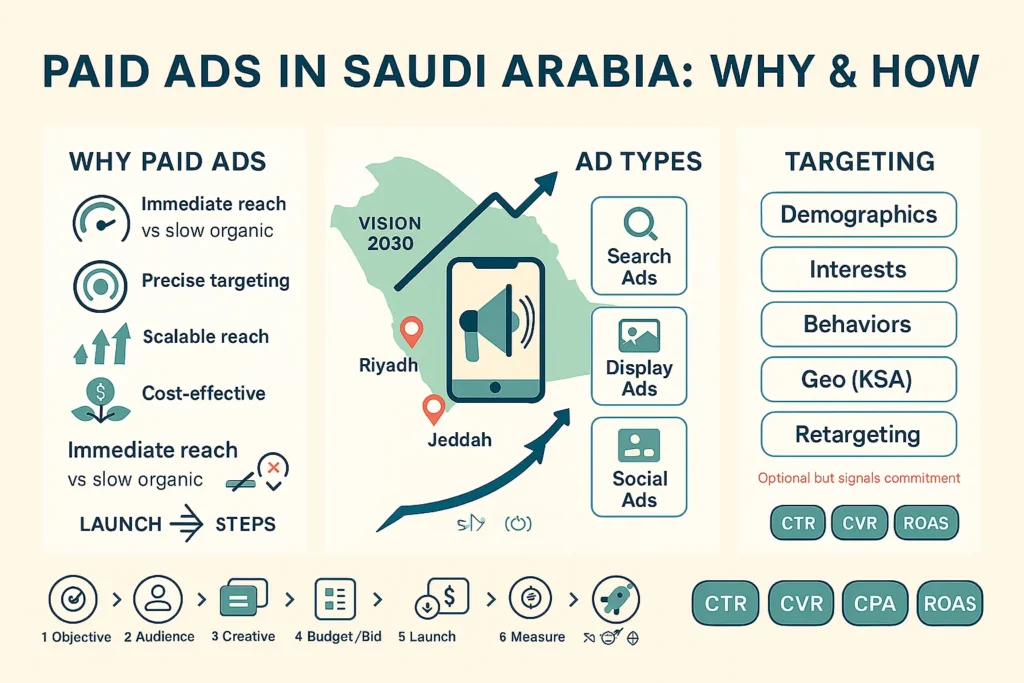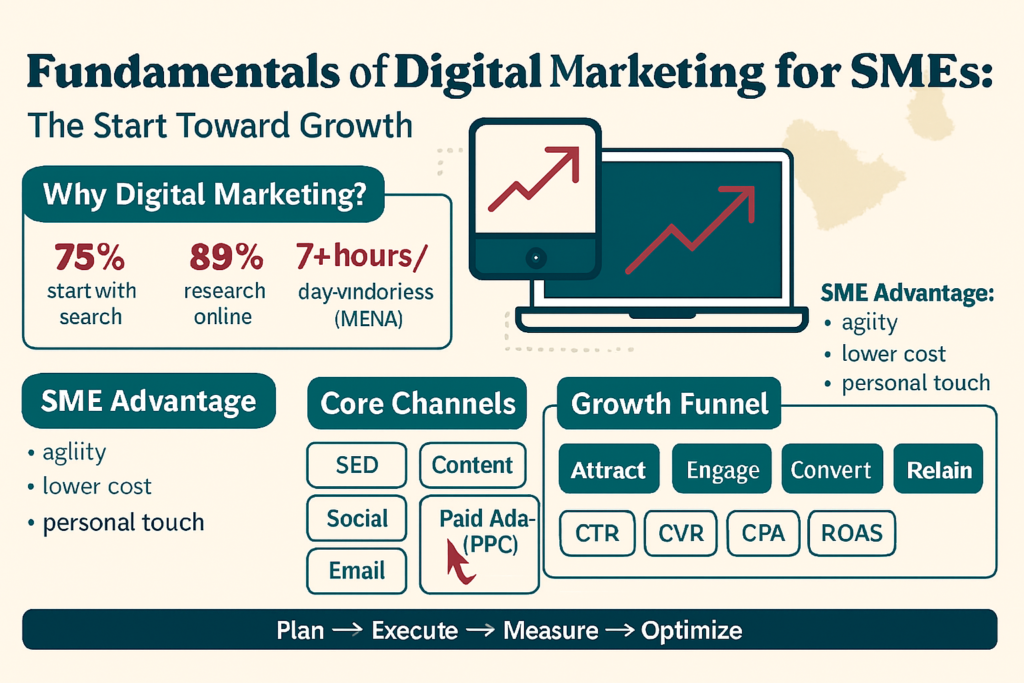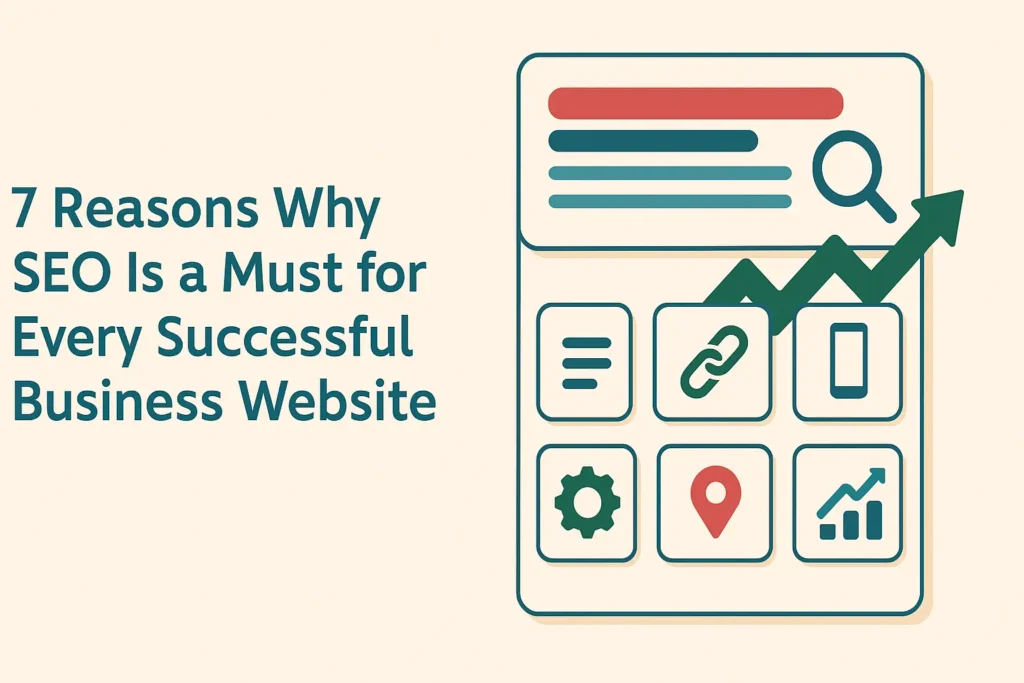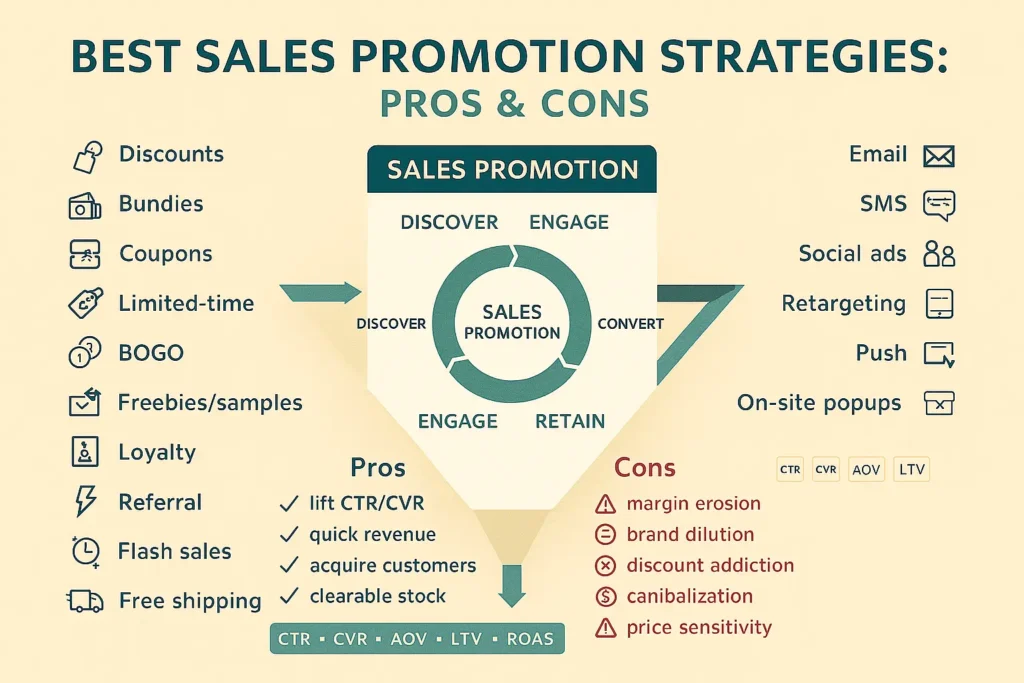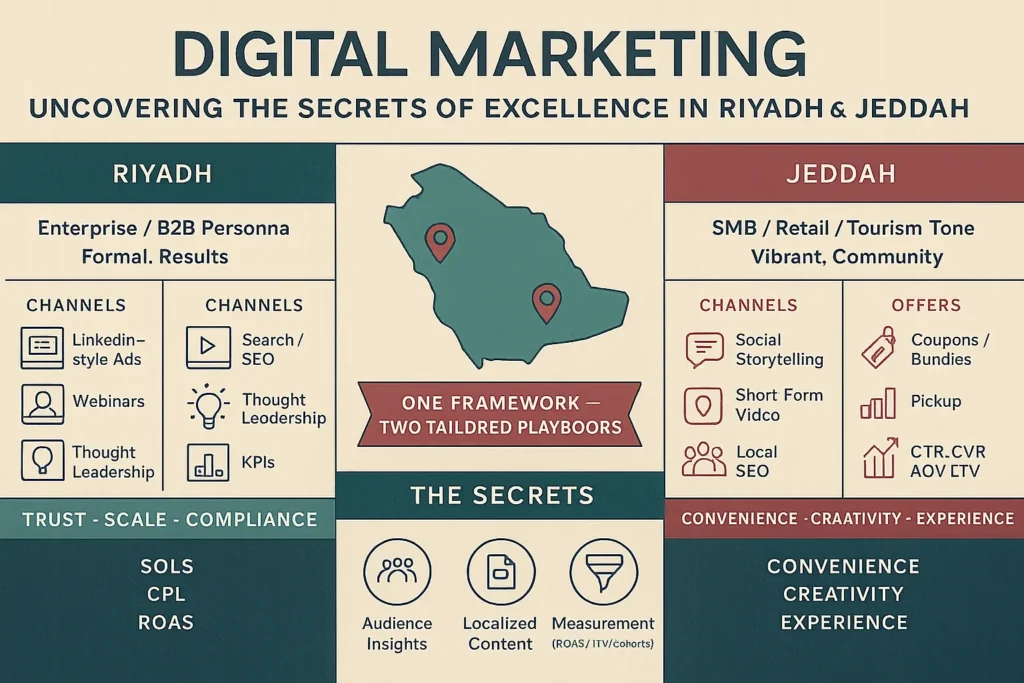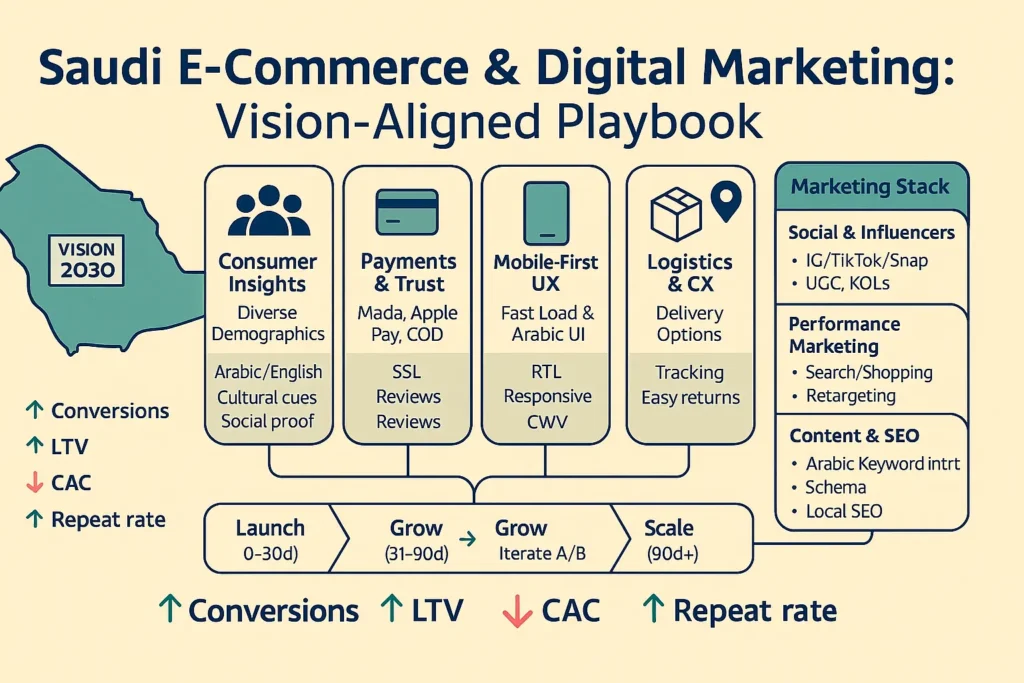
Successful E-Commerce and Digital Marketing Strategies for the Saudi Market
E-Commerce and Digital Marketing Strategies for Saudi Arabia
Amid the rapidly evolving digital landscape in Saudi Arabia, you stand on the threshold of unprecedented opportunity. Vision 2030 has radically reshaped the e-commerce and digital marketing sector, creating fertile ground for both entrepreneurs and established companies to thrive in the digital world.
Saudi Arabia’s digital market has witnessed tremendous growth, with e-commerce and marketing revenues reaching new heights year after year. Yet this growth brings rising competition and unique challenges that require a precise understanding of local consumer behavior, cultural preferences, and patterns of digital adoption. Success in this market demands more than simply translating global strategies; it requires a deep understanding of what drives Saudi consumers to make online purchasing decisions.
Your journey toward digital success in the Kingdom will involve several key challenges: understanding a diverse demographic landscape and cultural orientation, adapting to local payment options, and building trust in an environment that places significant weight on personal recommendations. Despite their complexity, these challenges present opportunities for those who address them strategically.
This comprehensive guide equips you with proven strategies tailored specifically to the Saudi market—covering everything from consumer psychology to advanced digital marketing techniques. By the end of this article, you’ll have a roadmap for creating and growing your e-commerce and marketing presence in one of the Middle East’s most dynamic markets.
Understanding the Saudi Digital Consumer
The Saudi digital consumer is a fascinating study in contrasts. You are targeting a market where tradition meets innovation, where the influence of social media intertwines with family recommendations, and where digital proficiency varies widely across demographic segments.
Demographics of Active Online Shoppers
The most active online shopping segment in Saudi Arabia falls between ages 18 and 34, accounting for over 60% of all digital transactions. This group shows high engagement with mobile apps, social platforms, and digital payment solutions. Women represent about 45% of online buyers, with particularly strong representation in beauty, fashion, and home goods categories. The geographic distribution is heavily skewed toward major urban centers, with Riyadh, Jeddah, and Dammam representing roughly 70% of e-commerce activity.
Shopping Behavior and Local Preferences
Saudi customers display a distinctive behavioral pattern that differs markedly from Western consumers. Peak shopping occurs between 8 p.m. and midnight, aligning with family time and social media engagement. Payment preferences show a strong inclination toward Cash on Delivery (COD), although adoption of digital payments is accelerating among younger demographics. The average consideration period before purchase tends to be longer than in many international markets, reflecting a cultural emphasis on reflection and family consultation.
Cultural and Traditional Influences on Purchase Decisions
Understanding cultural context is critical to your success. Saudi consumers place high value on authenticity, quality assurance, and social proof. Product reviews and testimonials carry exceptional weight—often influencing purchasing decisions more than promotional campaigns. The concept of wasta (personal connections and recommendations) translates directly into digital behavior, where influencer endorsements and peer reviews significantly shape buying choices.
The Importance of Trust and Credibility in Saudi Digital Environments
Building trust in Saudi Arabia’s e-commerce and marketing requires patience and consistency. Your customers need multiple touchpoints and credible social proof before committing to purchases. Prominently displaying security badges, showcasing customer reviews, and maintaining responsive Arabic-language customer service are non-negotiable elements that establish the credibility necessary for sustainable success.

Building a Robust Online Store for the Local Market
Creating an effective e-commerce platform for the Saudi market requires thoughtful attention to technical, cultural, and operational elements that align with local consumers.
Choosing the Right E-Commerce Platform
Prioritize platforms that support Arabic, right-to-left layouts, and integrations with local payment gateways. Shopify Plus and Magento Commerce offer reliable features for Arabic localization, while local platforms like Salla and Zid provide a native understanding of Saudi market requirements. Consider platforms that integrate seamlessly with popular local services such as SADAD, Mada, and various telecom billing systems.
Designing a User Interface Aligned with Saudi Taste
Your site design should reflect Saudi aesthetic preferences while maintaining modern functionality. Color palettes incorporating traditional elements such as gold, deep blue, and green resonate well (while varying by product category). Typography must elegantly support Arabic scripts, and the overall structure should align with the cultural preference for detailed product information and comprehensive imagery. Browsing patterns should feel intuitive for users familiar with both Arabic and English interfaces.
Enhancing User Experience and Ease of Navigation
Your on-site user journey should accommodate Saudi shopping habits, which often include independent research and product comparison. Implement robust filtering systems, in-depth product descriptions, and high-quality zoom functionality for product images. Checkout should be streamlined yet complete—allowing guest checkout while encouraging account creation through value-added incentives.
Integrating Local and International Payment Methods
Payment integration is a decisive success factor. In addition to supporting traditional options such as Cash on Delivery (COD), ensure compatibility with Mada cards, STC Pay, and SADAD, as well as international options like PayPal and major credit cards. The growing acceptance of Apple Pay and Samsung Pay among younger, digitally savvy segments makes these integrations increasingly important for capturing the full spectrum of the market.
Ensuring Security and Transaction Protection
Security concerns rank high among Saudi consumers’ priorities. Display security badges prominently, implement SSL certificates, and communicate your privacy policies clearly. Consider obtaining local certifications and memberships that bolster credibility—such as those issued by the Saudi Federation for Cybersecurity—or endorsements from local Chambers of Commerce.
The Importance of Mobile Compatibility
With more than 90% of internet users in Saudi Arabia accessing content via mobile devices, optimizing the mobile experience isn’t optional—it’s essential. Your mobile experience should be even faster and more intuitive than your desktop version, with touch-friendly navigation, rapid load times, and mobile-specific features such as one-tap ordering and integration with smartphone wallets.
SEO Strategies for the Saudi Market
SEO in the Saudi market requires an advanced understanding of local search behavior, linguistic nuances, and cultural contexts that influence how your target audience discovers and evaluates products online.
Local Keyword Research and Incorporating Regional Dialects
Your keyword strategy should include both Modern Standard Arabic and the regional dialect variations commonly used in Saudi search queries. Tools like SEMrush and Ahrefs provide valuable insights, but complementing them with local market research yields a deeper understanding. Focus on long-tail keywords that include location-specific terms, product categories in both Arabic and English, and phrases that reflect local purchase intent. For example, “أفضل متجر إلكتروني في الرياض” (best online store in Riyadh) or “توصيل سريع في جدة” (fast delivery in Jeddah) capture location-qualified search intent.
Optimizing Arabic Content and Local SEO Techniques
Creating Arabic content that’s SEO-friendly demands understanding how search algorithms process Arabic text. Ensure your content includes semantic variants of core terms, incorporates regional terminology, and reads naturally. Page titles and meta descriptions should be localized—Arabic for Arabic pages and English for international targeting—with proper implementation of hreflang for multilingual sites.
Building Strong Backlinks from Relevant Saudi Sites
Center your link-building strategy on relationships with authoritative Saudi websites, local business directories, and relevant industry portals. Publishing articles on Saudi business blogs, partnering with local influencers who also operate websites, and collaborating with complementary companies can generate valuable backlink profiles. Consider engaging with Saudi Chambers of Commerce, industry associations, and local business networks for legitimate link opportunities.
Optimizing for Local Search and Maps
Google Business Profile (formerly Google My Business) carries special importance in the Saudi market, where local search behavior is more nuanced. Keep your business information consistent across platforms, encourage Arabic-language reviews, and update business hours regularly—mindful of prayer times and local customs. Integrations with local mapping services and directories beyond Google Maps can capture additional local search traffic.
Implementing Structured Data and Business Information
Rich results and structured markup help search engines understand your business context within the Saudi market. Implement schema for products, reviews, local business information, and pricing in SAR. This technical SEO foundation supports better visibility in search results and boosts click-through rates from Saudi users.

Social Media Marketing
Marketing on social media in Saudi Arabia requires a precise approach that recognizes platform-specific preferences, content consumption habits, and engagement patterns among Saudi users.
The Most Popular Social Platforms in Saudi Arabia
Twitter Strategies for Reaching the Saudi Audience
Twitter retains a strong influence in Saudi Arabia, especially for real-time conversations and customer service. Your Twitter strategy should prioritize timely responses to customer inquiries, participation in trending conversations relevant to your industry, and sharing valuable content in both Arabic and English. Use Twitter’s advanced targeting options to reach Saudi users during peak hours—typically between 7:00 p.m. and 11:00 p.m. local time.
Leveraging Instagram for Visual Marketing
Instagram’s visual-first approach aligns perfectly with Saudi consumers’ preference for product discovery and brand engagement. Focus on high-quality imagery that matches local aesthetic preferences, behind-the-scenes content that builds authenticity, and Stories features that encourage direct interaction. Instagram’s shopping capabilities allow seamless integration with your eCommerce platform, reducing friction between discovery and purchase.
Snapchat’s Impact on Younger Demographics
Snapchat enjoys strong adoption—particularly among younger Saudis—making it essential for brands targeting ages 16–30. Create engaging AR filters related to your products, share exclusive behind-the-scenes content, and collaborate with local Snapchat influencers who understand the cultural nuances of this segment.
TikTok and Interactive Entertainment Content
TikTok’s explosive growth in Saudi Arabia creates opportunities for creative brand expression and viral marketing. Focus on entertaining and educational content that demonstrates product benefits through storytelling, challenges that encourage user-generated content, and collaborations with local creators who can authentically represent your brand values.
Building a Consistent Cross-Platform Content Strategy
Your cross-platform strategy should maintain brand consistency while adapting to each platform’s characteristics. Develop a content calendar that accounts for local events, religious observances, and cultural celebrations. Ensure your messaging remains consistent whether delivered through Twitter’s text-first format, Instagram’s visual storytelling, or TikTok’s entertainment-driven content.
Collaborating with Local Influencers
Influencer partnerships in Saudi Arabia require careful selection based on audience alignment, content quality, and cultural authenticity. Micro-influencers often deliver higher engagement rates and more authentic ties with followers. Set clear expectations for content deliverables, disclosure requirements, and performance standards while preserving the creator’s authentic voice.
Community Management and Customer Engagement
Community management in the Saudi market demands 24/7 attention and culturally sensitive responses. Train your social team to understand local customs, appropriate response times, and escalation procedures for sensitive issues. Encourage user-generated content via contests, hashtag campaigns, and customer spotlight features that build community engagement.
Content Marketing and Building Long-Term Relationships
Content marketing in Saudi Arabia requires a strategic approach that balances educational value, cultural relevance, and commercial goals while fostering lasting connections with your audience.
Creating Valuable Content Aligned with Saudi Audience Interests
Your content strategy should address the specific interests, challenges, and aspirations of Saudi consumers. Focus on topics resonant with local lifestyle preferences, such as family-oriented content during Ramadan, fashion tips for different occasions, or tech reviews that consider local usage patterns. Educational content performs well, whether it’s how-to videos, buying guides, or industry insights that position your brand as a trusted authority.
Educational Writing and Blogging Strategies
Develop an integrated blogging strategy that blends evergreen educational content with timely, topical pieces. Articles that address common customer questions, detailed product comparisons, and industry-trend analyses build expertise while improving search visibility. Ensure your blog content is available in Arabic to maximize reach and engagement with local readers.
Using Video and Visual Content
Video consumption in Saudi Arabia has reached unprecedented levels, making it essential to your content strategy. Produce product explainer videos, compilations of customer testimonials, and behind-the-scenes content that builds brand transparency. Live streaming during peak engagement windows can drive real-time interaction and trigger immediate conversions.
Interactive Content and Gamification
Interactive elements—such as polls, quizzes, and branded mini-games—generate high engagement among Saudi users. Build content experiences that encourage participation while showcasing product benefits indirectly. Interactive calculators, style quizzes, or sustainability assessments can deliver value while collecting valuable customer data.
The Role of Storytelling and Heritage in Marketing Content
Saudi consumers respond strongly to narrative content that weaves together cultural heritage, family values, and personal success stories. Craft brand stories that document traditional values while embracing modern aspirations. Customer success stories, founder journeys, and community-impact narratives resonate particularly well with Saudi audiences.
Measuring Content Impact and Optimizing Strategy
Implement comprehensive analytics to track content performance across all channels. Monitor engagement rates, time-on-content, social sharing patterns, and conversions from content to purchase. Use these insights to refine your content calendar, adjust posting cadences, and identify the most effective formats for your specific audience segments.
Email Marketing and Automation
Email marketing in the Saudi market demands sophisticated strategies for audience segmentation, personalization, and automation—while respecting cultural preferences and driving commercial results.
Building Strong, Targeted Email Lists
Your email acquisition strategy should emphasize value exchange over aggressive collection tactics. Offer exclusive content, early access to sales, or valuable resources in return for subscriptions. Implement progressive profiling to collect additional information about subscriber preferences, purchase history, and engagement patterns—without overwhelming initial signups.
Personalizing Messages Based on Customer Behavior
Behavioral segmentation enables targeted email campaigns tailored to individual customer journeys. Create automated sequences based on browsing history, purchase patterns, seasonal preferences, and engagement levels. Personalization extends beyond first names to include product recommendations, content preferences, and optimized contact frequency.
Automating the Customer Journey from Discovery to Purchase
Develop advanced automation workflows that nurture customers throughout the entire lifecycle. Welcome series for new subscribers, educational sequences for those in the consideration stage, and post-purchase follow-ups create seamless customer experiences. Account for the longer contemplation periods common in the Saudi market by building extended nurture sequences that deliver ongoing value without feeling pushy.
Abandoned Cart Recovery Strategies
Cart abandonment rates in Saudi Arabia often exceed global averages due to payment constraints and extended contemplation periods. Deploy multi-touch cart-recovery sequences that address common concerns, present alternative payment options, provide additional product information, and include social proof elements. Time follow-ups strategically, mindful of local time zones and cultural considerations around communication timing.
Improving Open Rates and Engagement
Subject-line optimization for the Saudi market requires understanding language preferences, cultural cues, and engagement triggers. A/B test different approaches—Arabic vs. English subject lines, urgency-based offers vs. value propositions, and varying personalization levels—to identify the optimal strategies for your specific audience.
Compliance with Privacy Laws and Email Marketing Regulations
Ensure full compliance with Saudi data protection regulations and international email best practices. Implement clear opt-in processes, provide easy unsubscribe options, and maintain transparency in your data-use policies. Ongoing list hygiene and engagement-based segmentation help preserve sender reputation and deliverability rates.
Paid Advertising and ROI Optimization
Paid advertising in the Saudi market requires sophisticated strategies for targeting, budgeting, and performance optimization—taking into account local competition levels and consumer behavior patterns.
Google Ads Targeting and Local Search
Your Google Ads strategy should leverage advanced targeting capabilities to reach Saudi consumers at different stages of the buying journey. Focus on location-based targeting that accounts for delivery capabilities, ad scheduling aligned with local engagement patterns, and device targeting that prioritizes mobile optimization. Your keyword bidding strategies should account for rising competition during peak shopping periods and seasonal events.
Facebook and Instagram Campaigns
Meta’s ad platform offers advanced targeting options that are highly valuable in the Saudi market. Use detailed demographic targeting, interest-based segmentation, and lookalike audiences modeled on your best customers. Creative optimization should focus on high-quality visuals, culturally appropriate messaging, and clear value propositions aligned with local preferences.
Geographic and Demographic Targeting Strategies
Implement precise targeting that recognizes the diversity within Saudi Arabia’s population. Urban vs. rural targeting, age-based segmentation, and gender-specific local campaigns all require distinct creative approaches and budgets. Consider setting up separate campaigns for different regions to suit varying preferences and market requirements.
Campaign Optimization and Budget Management
Develop a systematic optimization approach that includes periodic bid adjustments, audience refinement, and creative rotation. Budget allocation should reflect seasonality, competitive periods, and the testing needs of new campaigns. Deploy automated bidding strategies where appropriate while maintaining manual oversight for strategic control.
Measuring Ad Performance and Analyzing Results
Comprehensive performance measurement goes beyond basic metrics to include customer lifetime value, attribution analysis, and cross-channel impact evaluation. Implement conversion tracking that accounts for the extended purchase cycles common in the Saudi market, and use advanced attribution models to understand the full customer journey from first touch to conversion.
Retargeting Strategies and Lifting Conversions
Retargeting in Saudi Arabia should account for longer contemplation periods and the need for multiple touchpoints. Build segmented retargeting lists based on engagement levels, page visits, and time since last interaction. Dynamic retargeting campaigns that display viewed products with personalized messaging deliver higher conversion rates than generic promotional campaigns.
Mobile Commerce Optimization and Smart Apps
Mobile commerce is a decisive success factor in the Saudi market, where smartphones lead internet usage and shopping behavior.
The Importance of Mobile Shopping in Saudi Arabia
Mobile eCommerce in Saudi Arabia has moved beyond convenience to become the preferred shopping method for most consumers. Your mobile strategy should recognize that the phone is not just another channel—it’s often the primary and sometimes only way customers interact with your brand. A mobile-first design philosophy should guide all development decisions, from wireframes to final execution.
Designing Responsive, Mobile-Optimized Sites
Your mobile site must deliver outstanding performance across device types and typical Saudi network conditions. Implement Progressive Web App (PWA) techniques that provide app-like experiences via the browser, optimize image compression and loading sequences for mobile networks, and ensure comfortable navigation that suits varying screen sizes and interaction patterns.
Building Smart Shopping Apps
Native mobile apps create opportunities to deepen engagement and improve conversion rates. Your app should deliver value beyond the mobile website with features such as push notifications, offline browsing, personalized recommendations, and integrated loyalty programs. Consider AR product visualization and social-sharing features that tap into Saudi users’ high social media engagement.
Smart Use of Push Notifications
Push-notification strategies require a careful balance between engagement and user experience. Personalize notifications based on user behavior, shopping history, and preferences—while respecting cultural considerations around timing and frequency. Thoughtful reminders for abandoned carts, price-drop alerts, and exclusive offers can increase engagement when executed with care.
Optimizing Mobile Checkout
Your mobile checkout should accommodate the variety of preferred payment methods in Saudi Arabia. Implement one-tap checkout, stored payment methods, and wallet integrations while maintaining security standards that build customer trust. Consider installment options and “buy now, pay later” services, which are popular among younger segments.
Integrating with Local Digital Wallets
Seamless integration with popular Saudi digital wallets—such as STC Pay, Al Rajhi wallet, and emerging fintech solutions—can significantly improve conversion rates. Ensure your payment integration supports real-time transaction confirmations, automatic receipt generation, and dedicated customer-support paths for payment queries.
Keep reading and uncover secrets that can change the way you work. Get More Leads with Our Proven Content Marketing Strategies
Customer Retention and Loyalty Building
Building customer loyalty in Saudi Arabia requires understanding local values, nurturing long-term relationships, and delivering consistent value beyond the first transaction.
Tailored Loyalty and Rewards Programs
Your loyalty program should reflect Saudi cultural values around recognition, status, and community belonging. Implement tiered rewards structures with increasing benefits for higher engagement, exclusive access to products or events, and personalized rewards based on purchase history and preferences. Consider charitable-giving options that let customers donate rewards to local causes—aligning with the strong cultural emphasis on social responsibility.
Excellent Customer Service and Arabic Support
World-class service in Saudi Arabia demands multilingual capability, cultural sensitivity, and responsiveness that exceeds international benchmarks. Train your service team on local customs, appropriate greeting/closing protocols, and escalation procedures that preserve customer dignity. Offer multi-channel support, including WhatsApp, which is widely used for business communication in Saudi Arabia.
Personalizing Offers Based on Purchase History
Use customer data to create highly personalized offer strategies that demonstrate your understanding of individual preferences and shopping patterns. Implement predictive analytics to anticipate customer needs, seasonal buying behavior, and event-driven shopping triggers. Extend personalization to communication preferences, product recommendations, and promotional timing.
Leveraging Reviews and Testimonials in Marketing
Customer reviews and testimonials carry exceptional weight in Saudi purchase decisions, making them essential to your retention strategy. Establish regular review-collection processes, feature positive feedback prominently across all marketing channels, and incorporate customer success stories into your creative. Consider visual testimonials that showcase authentic customer voices and experiences.
Creating Digital Customer Communities
Foster community through exclusive Facebook groups, WhatsApp communities, or dedicated forum spaces where customers can share experiences, ask questions, and connect with your brand and each other. Actively moderate these communities to maintain positive environments while providing valuable content and exclusive offers that reward participation.
Referral and Advocacy Marketing
Given the importance of word-of-mouth in Saudi culture, referral strategies are especially effective. Design referral incentives that reward both advocates and new customers, track referral success rates across segments, and build social-sharing tools that make referrals easy and natural. Consider ambassador programs for your most engaged customers, who can embody your brand values within their networks.
Keep reading and uncover secrets that can change the way you work. Is Product Marketing Worth Hiring? Here Are the Numbers and Benefits
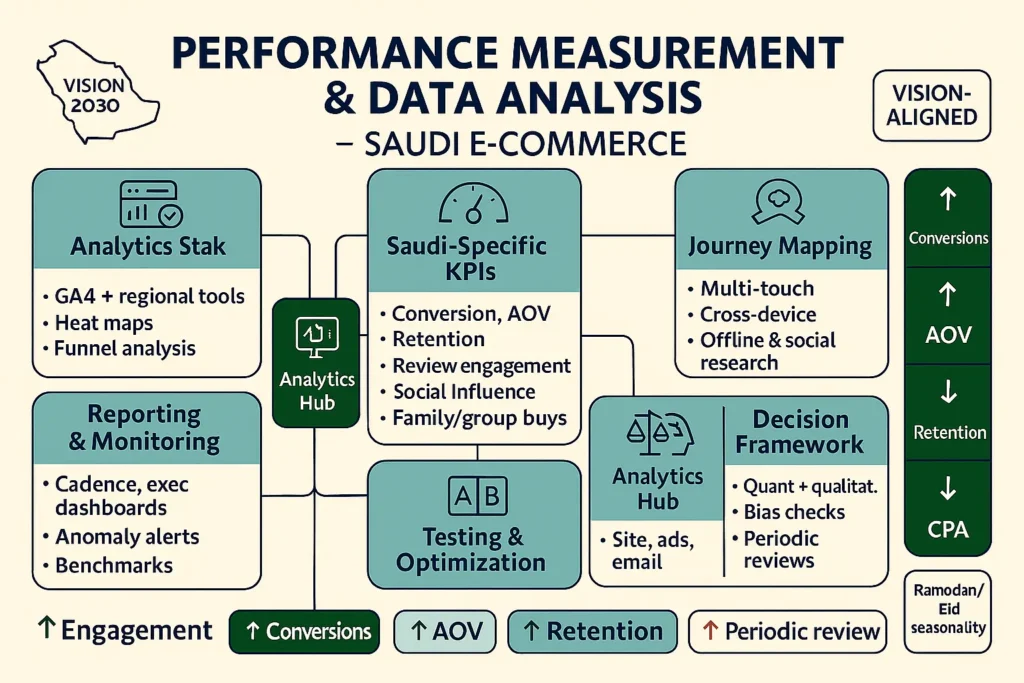
Performance Measurement and Data Analysis
Data-driven decision-making in Saudi e-commerce and marketing requires sophisticated analytics, cultural context, and continuous optimization based on insights.
Core Analytics Tools for eCommerce
Your analytics stack should combine global tools like Google Analytics 4 with regional solutions that provide deeper visibility into Saudi consumer behavior. Implement heat-mapping tools to understand interaction patterns, conversion-funnel analysis to identify optimization opportunities, and customer-journey mapping to account for extended decision cycles common in Saudi Arabia.
Key KPIs for the Saudi Market
Develop a KPI framework that reflects both global eCommerce best practices and Saudi-specific considerations. Track metrics such as conversion rate, average order value, and retention—but also culturally relevant signals like review-engagement rates, social media influence on purchases, and family/group buying patterns. Monitor seasonal fluctuations tied to religious observances, cultural celebrations, and regional events that affect shopping behavior.
Customer Behavior Analysis and Journey Mapping
Understanding the Saudi customer journey means recognizing multiple touchpoints, extended contemplation periods, and family influence on purchase decisions. Implement attribution models that consider offline influences, social research phases, and peer-consultation periods that may occur between initial interest and final purchase. Track cross-device behaviors and social activities that shape buying decisions.
Using Data to Improve Strategy
Convert analytics insights into actionable strategic improvements through structured testing and optimization processes. Run A/B tests on website elements, email campaigns, and ad creatives—while accounting for cultural preferences and local market conditions. Use cohort analysis to understand how customer behavior changes over time and recognize seasonal patterns for better inventory planning and timely marketing.
Regular Reporting and Continuous Monitoring
Set reporting cadences that align with business-planning cycles while delivering timely insights for tactical improvements. Build executive dashboards highlighting key trends, automated alerts for significant metric shifts, and detailed analytical reports that guide strategic decisions. Include competitive benchmarking and market-trend analysis relevant to Saudi eCommerce.
Data-Driven Decision-Making
Develop decision frameworks that blend quantitative data with qualitative market understanding. Train your team to interpret analytics in a cultural context, recognize data limits and biases, and make strategic adjustments based on comprehensive analysis rather than isolated metrics. Establish periodic strategy reviews that incorporate performance data and market intelligence.
Keep reading and uncover secrets that can change the way you work. How Social Media Marketing in Jeddah Can Skyrocket Your Sales with AI Support
Your Path to Sustainable Success in Saudi Arabia’s Digital Market
The strategies outlined in this comprehensive guide are your roadmap to success in Saudi Arabia’s dynamic eCommerce landscape. Winning here requires more than implementing global best practices—it demands a deep understanding of local consumer behavior, cultural differences, and market-adaptation techniques.
Implementing the Core Strategic Elements
Kick off your implementation by prioritizing strategies that closely match your current capabilities and market position. First, build a strong foundation through platform optimization and local market research, then gradually implement more advanced techniques like automation and sophisticated targeting. Sustainable success comes from consistent execution—not trying to implement everything at once.
Practical Tips to Get Started
Begin with thorough market research, including direct customer feedback, competitor analysis, and cultural consultations with local market experts. Build relationships with Saudi service providers for payments, logistics, and customer support. Validate assumptions with small-scale campaigns before committing significant resources to full releases.
The Importance of Adapting to Market Changes
Saudi Arabia’s digital market continues to evolve rapidly, driven by Vision 2030 initiatives, shifting consumer preferences, and technological advancements. Stay informed about regulatory changes, emerging platforms, and shifts in cultural attitudes that may impact your business. Build operational agility that can quickly adapt to market opportunities and challenges.
The Role of Continuous Development in Ensuring Success
Invest in ongoing team development, tech upgrades, and strategy refinement based on performance data and market insight. Establish feedback loops that capture customer input, monitor competitor actions, and identify emerging trends that could affect your business. Maintain a test-and-learn mindset—treating every campaign, product launch, and customer interaction as an opportunity to learn and improve.
The Future Vision for e-commerce and marketing in Saudi Arabia
The outlook points to deeper AI integration, AR-enhanced shopping, and personalized commerce solutions. Social commerce will likely continue to gain importance, while the line between online and offline retail will blur through integrated experiences. Position your business to harness these trends with flexible technology infrastructure and a customer-centric approach.
Start Your Digital Success Journey
Your success in Saudi Arabia’s digital market begins with a strategic first step. Whether that means optimizing your current website for local preferences, launching your first Arabic social campaign, or implementing advanced analytics tracking, the key is to start with clear goals and measurable outcomes.
Opportunities in Saudi eCommerce have never been greater, but success requires dedication, cultural understanding, and strategic execution. By implementing the strategies outlined in this guide—and staying agile to market feedback and changing conditions—you’ll position your business for sustained growth in one of the world’s most promising digital markets.
Turn your goals into real achievements with our tailored services – request the service now.
FAQs
What are the best e-commerce platforms for the Saudi market?
Platform selection should prioritize Arabic language support, integration with local payment gateways, and mobile optimization. Shopify Plus offers robust international features with Arabic localization; regional platforms like Salla and Zid provide a native understanding of Saudi requirements. Magento Commerce delivers enterprise-level customization, while WooCommerce offers cost-effective solutions for smaller businesses. Consider factors like your technical capacity, budget constraints, scale needs, and integration with local services when deciding.
How can we improve conversion rates for e-commerce stores?
Improving conversion in Saudi Arabia requires understanding local shopping behaviors and preferences. Implement trust signals such as security badges, customer testimonials, and clear return policies. Optimize your checkout by offering multiple payment methods—including cash on delivery—reducing form fields, and providing transparent shipping information. Use social proof through reviews and ratings, create urgency with limited-time offers, and ensure fast mobile load times. Regular testing of product pages, offers, and CTAs can reveal improvement opportunities specific to your audience.
What are the main challenges in e-Commerce and marketing in Saudi Arabia?
Key challenges include navigating cultural sensitivities while creating compelling content, building trust in a market where personal recommendations carry significant weight, and competing effectively in an increasingly crowded digital landscape. Language considerations require balanced use of Arabic and English, while familiarity with local dialects and cultural references strengthens audience connection. Technical challenges include mobile-first optimization and integration with local payment and logistics systems. Evolving regulatory and privacy requirements add complexity to data-collection and usage strategies.
How can we measure the success of e-Commerce and marketing campaigns?
Measuring success combines standard e-commerce and marketing metrics with Saudi-specific indicators. Track conversion rates, customer acquisition costs, and ROAS alongside cultural signals like social engagement rates, review generation, and referral patterns. Implement attribution modeling that accounts for extended purchase cycles and multiple common touchpoints. Monitor brand awareness by tracking social mentions, customer survey feedback, and organic search performance. Use cohort analysis to understand customer lifetime value and retention patterns, and benchmark performance against industry standards appropriate to the Saudi market context.

